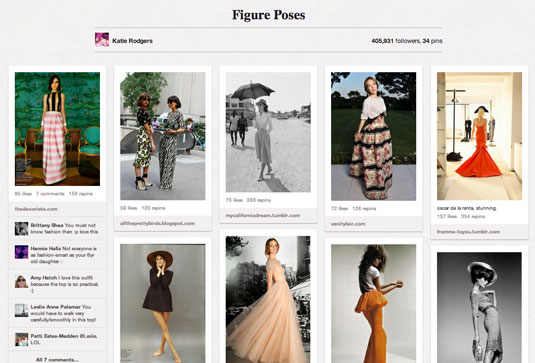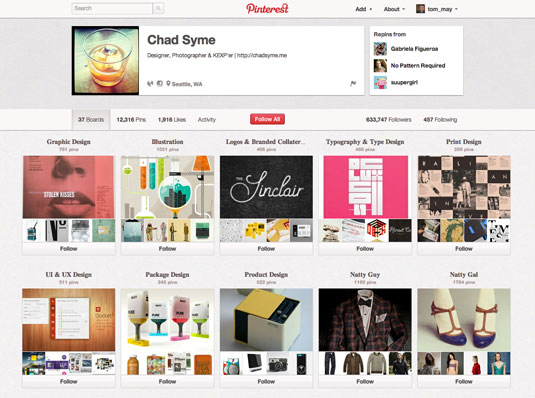8 ways to boost your design career using Pinterest
Get work, find new contacts and promote your personal brand: we reveal how to harness the power of the image-based social network.
Pinterest.com is part social network, part powerful visual bookmarking tool. There's a little bit of Twitter in its digital DNA, a dash of Facebook and a large slab of Delicious. And if you're a graphic designer, artist or illustrator, you should definitely be using it.
Instead of bookmarking pages, you bookmark, store and share images and videos. See a photo you like? You can quickly 'pin' it to a virtual board in your Pinterest account as easily as you can tweet an article.
The interface is simple and easy to use. You can create up to 350 boards and these boards can be viewed by anyone and everyone that follows you (although there is an option to create 'secret boards', which are private). Like Twitter, you can follow other Pinterest users and see what they've been pinning on a personalised homepage. You can also 'Re-pin' any images you like to your own boards.
And like Facebook, you can 'Like' or comment on any images you see, enhancing their popularity on the site.
What do people pin?
People pin anything and everything. There are a wide range of categories to browse, ranging from architecture to weddings, with food, home decor and technology inbetween.
Drop by the Pinterest homepage at any time and you'll see an eclectic mix of artwork, favourite photos, typography and crafts. There are many uses for Pinterest that make it an ideal platform for graphic designers and illustrators. Try these 10 ideas for starters...
- Looking for a job? Try the Creative Bloq jobs board!
01. Create virtual inspiration boards

You can use Pinterest to create themed inspiration boards for things like: looks, styles, colours, contrasts, shapes, textures, patterns, typography, objects, landscapes, and people.
See it. Pin it. Store it. It's that easy and a great way to build up a library of inspirational material that you can reference in your designs or illustrations. There's also a Pinterest iPhone app so you can pin web pages and photos on the go. And by browsing the Pinterest website itself, you can often discover some great ideas.
Fashion designer and keen pinner Katie Rodgers, for example, has a 'figure poses' board, a visual notebook of poses that she might want to use in future illustrations.
02. Create a mood board for a client
If you're working on a design project for a client, consider creating a mood board or examples board on Pinterest that they can view. It's a very convenient way to collect and display concept material that a client can view in one place. Normally every board on Pinterest is publicly viewable, so you may wish to create them as 'secret boards'.
Pinterest also has the ability to invite other people to contribute to a board. This allows you to crowdsource a mood board, perhaps involving key project stakeholders.
03. Sell your work
Pinterest has a dedicated Gifts section for objects and artwork, ranging from $1 to $500 and upwards. Click a link and you'll be taken to a page where you can buy the featured product.
See the potential here? As long as you don't overdo it, you could promote and sell your designs or artwork using Pinterest as a lead generator. You'll still need a shopping cart and a website to do the actual selling, however.
04. Connect with other designers
Pinterest should be part of every designer, artist and illustrator's social media strategy alongside the likes of Facebook, Twitter, Google+, Behance, Dribbble and deviantART.
With Pinterest's ability to follow other pinners, you can easily keep track of designers, studios, photographers or illustrators that you like. By following and sharing their content, you might encourage them to check you out in return, raising your profile. Remember that you can comment on other's posts, just like on other social networks: this is a great way to get connected with other designers.
Let people know who you are and what you do by including it in your About section. Include any relevant keywords in the description so that someone people searching for a particular kind of designer can find you easily. Also include a link to your website.
05. Use it as an extension of your portfolio

As well as pinning other people's visuals, why not create a board for your own work and pin your best stuff to it? This will give it more exposure on the web, draw comments and attract 'Likes'. Your work might even be re-pinned and shared by other Pinterest users.
With this in mind, be sure to include your name/business name in the description of your image. Or, better still, watermark your own submissions with your logo and website address. But don't fall foul of Pinterest etiquette...
06. Add 'Pin it' buttons to your website
You may have Twitter and Facebook buttons on your website, but what about Pinterest? Make it easy for Pinterest users to share your content by adding a 'Pin it' button alongside any other social media sharing tools. It could be the start of something big. You'll find instructions on how to add the button here.
07. Research topics and find inspiration
When trying to come up with ideas around a brief, many designers will default to a Google Image search. But as you'll know from experience, some of the results Google throws up can be a bit random and off-topic. Searching an image-focused site like Pinterest, where most users put effort into grouping their images around a theme, can be much more fruitful.
08. Follow Creative Bloq!

Did you know that we're on Pinterest? Follow us today and get a burst of creative inspiration! You should also follow our sister title Computer Arts's Pinterest page.
Now read:
- Brilliant Pinterest boards every designer should follow
- Boost your design career with social media
- Discover the top 20 networking tips for designers!
Are you using Pinterest? How are you using it? Got any tips you'd like to share? Let us know in the comments below.

Thank you for reading 5 articles this month* Join now for unlimited access
Enjoy your first month for just £1 / $1 / €1
*Read 5 free articles per month without a subscription

Join now for unlimited access
Try first month for just £1 / $1 / €1
Get the Creative Bloq Newsletter
Daily design news, reviews, how-tos and more, as picked by the editors.

The Creative Bloq team is made up of a group of design fans, and has changed and evolved since Creative Bloq began back in 2012. The current website team consists of eight full-time members of staff: Editor Georgia Coggan, Deputy Editor Rosie Hilder, Ecommerce Editor Beren Neale, Senior News Editor Daniel Piper, Editor, Digital Art and 3D Ian Dean, Tech Reviews Editor Erlingur Einarsson, Ecommerce Writer Beth Nicholls and Staff Writer Natalie Fear, as well as a roster of freelancers from around the world. The ImagineFX magazine team also pitch in, ensuring that content from leading digital art publication ImagineFX is represented on Creative Bloq.
